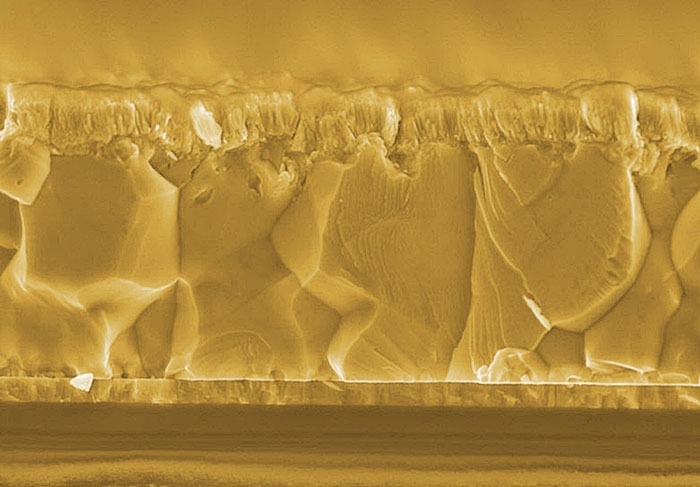News: Photovoltaics
16 December 2022
Bifacial thin-film solar cells based on copper indium gallium diselenide (CIGS) can collect solar energy from both their front side and their rear side – and thus potentially yield more solar electricity than their conventional counterparts. So far, however, their fabrication has led to only modest energy conversion efficiencies. A team at the Swiss Federal Laboratories for Materials Science and Technology (Empa) has now developed a new low-temperature production process resulting in record efficiencies of 19.8% for front illumination and 10.9% for rear illumination. Moreover, they also produced the first bifacial perovskite-CIGS tandem solar cell, opening up the possibility of even higher energy yields in future (S-C Yang et al, ‘Efficiency boost of bifacial Cu(In,Ga)Se2 thin-film solar cells for flexible and tandem applications with silver-assisted low-temperature process’, Nature Energy (2022); 21 November).
If both direct sunlight as well as its reflection (via the rear side of a solar cell) can be collected, this should increase the yield of energy that the cell produces. Potential applications are, for example, building-integrated photovoltaics (BIPVs), agrivoltaics – the simultaneous use of areas of land for both photovoltaic power generation and agriculture – and vertically or high-tilt installed solar modules on high-altitude ground. According to the International Technology Roadmap of Photovoltaics, bifacial solar cells could capture a market share of 70% of the overall photovoltaics market by 2030.

Although bifacial solar cells based on silicon wafers are already on the market, thin-film solar cells have so far lagged behind. This is, at least in part, due to the rather low efficiency of bifacial CIGS thin-film solar cells, caused by a critical bottleneck problem: For any bifacial solar cell to be able to collect reflected sunlight at the rear side, an optically transparent electrical contact is a prerequisite. This is achieved by using a transparent conductive oxide (TCO) that replaces the opaque back contact in conventional – i.e. mono-facial – solar cells made of molybdenum.
Detrimental oxide formation
High-efficiency CIGS solar cells are generally produced by a high-temperature deposition process, i.e. above 550°C. At these temperatures, however, a chemical reaction occurs between the gallium (of the CIGS layer) and the oxygen of the transparent conductive oxide back contact. The resulting gallium oxide interface layer blocks the flow of sunlight-generated current and thus reduces the energy conversion efficiency of the cell. The highest values achieved so far in a single cell are 9.0% for the front side and 7.1% for the rear side. “It’s really difficult to have a good energy conversion efficiency for solar cells with both front and rear transparent conducting contacts,” says Ayodhya N. Tiwari, who leads Empa’s Thin Film and Photovoltaics lab.

Picture: Bifacial CIGS solar cells consist of very thin layers, only 3µm in total for the active materials. Deposited on top of a transparent electrical contact, the CIGS polycrystalline layer absorbs the light from both front and back sides. (Courtesy of EMPA.)
So, PhD student Shih-Chi Yang in the group of Romain Carron in Tiwari’s lab developed a new low-temperature deposition process that should produce much less of the detrimental gallium oxide – ideally none at all. They used a tiny amount of silver to lower the melting point of the CIGS alloy and to obtain absorber layers with good electronic properties at just 350°C deposition temperature. When they analyzed the multi-layer structure with high-resolution transmission electron microscopy (TEM), with the help of Tiwari’s former postdoc Tzu-Ying Lin( currently at National Tsing Hua University in Taiwan), the team could not detect any gallium oxide at the interface at all.
Targeting an energy yield of more than 33%
This was also reflected by a drastically improved energy conversion efficiency: The cell yielded values of 19.8% for front illumination and 10.9% for rear illumination that had been independently certified by the Fraunhofer Institute for Solar Energy Systems (ISE) in Freiburg, Germany – in the very same cell on a glass substrate.
The team also succeeded in fabricating, for the very first time, a bifacial CIGS solar cell on a flexible polymer substrate, which – due to their light weight and flexibility – widens the spectrum of potential applications.
Finally, the researchers combined two photovoltaic technologies – CIGS and perovskite solar cells – to produce a bifacial tandem cell.
According to Tiwari, bifacial CIGS technology has the potential to yield energy conversion efficiencies beyond 33%, opening up further opportunities for thin-film solar cells in the future. Tiwari is now trying to establish a collaborative effort with key labs and companies across Europe to expedite the technology development and its industrial manufacturability on a larger scale.
- SEO Powered Content & PR Distribution. Get Amplified Today.
- Platoblockchain. Web3 Metaverse Intelligence. Knowledge Amplified. Access Here.
- Source: https://www.semiconductor-today.com/news_items/2022/dec/empa-161222.shtml



